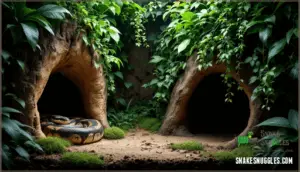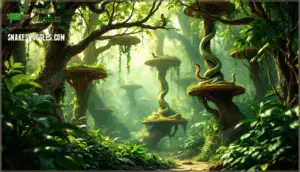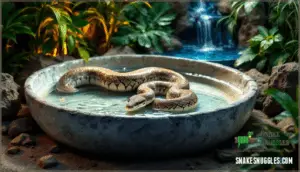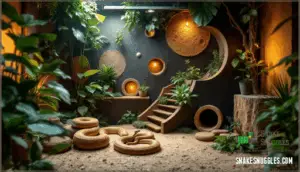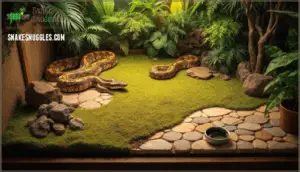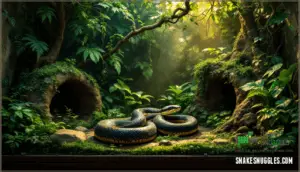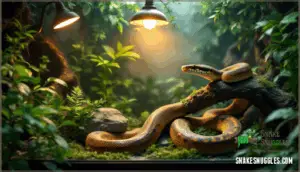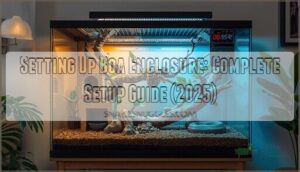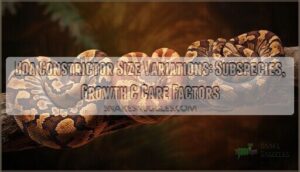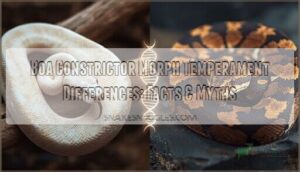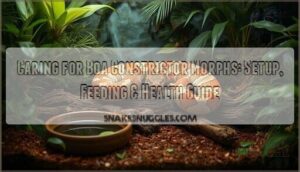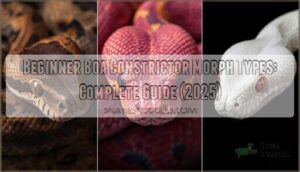This site is supported by our readers. We may earn a commission, at no cost to you, if you purchase through links.
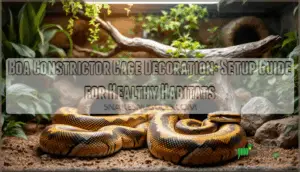
The right cage decoration creates thermal gradients that prevent respiratory infections. It offers climbing structures that build muscle tone. It provides hiding spots that reduce stress-related feeding strikes. Compare a minimalist setup to a thoughtfully decorated habitat, and you’ll see the difference in your snake’s conduct within weeks.
The challenge lies in choosing decorations that balance safety, function, and your boa’s natural instincts.
Table Of Contents
- Key Takeaways
- Choosing The Best Boa Constrictor Cage
- Essential Decor for Boa Enclosures
- Substrate and Flooring Choices
- Enhancing Habitat With Plants and Accessories
- Creating a Stimulating and Healthy Environment
- Frequently Asked Questions (FAQs)
- Which type of Boa constrictor cage should I buy?
- Can Boa constrictor cages be used for Pythons?
- How do I choose a boa enclosure?
- Why should you buy a red tail Boa cage?
- What makes a good Boa setup?
- How often should I rearrange cage decorations?
- Can I use rocks from outside safely?
- What lighting schedule works best for boas?
- How do I sanitize decorations between cleanings?
- Should baby boas have different decoration styles?
- Conclusion
Key Takeaways
- A properly decorated boa constrictor enclosure requires thermal gradients, climbing structures, and multiple hides to prevent health issues like respiratory infections and stress-related feeding problems, with effects visible in the snake’s behavior within weeks.
- The enclosure foundation matters critically—PVC materials retain humidity and heat about 20% better than glass while costing $300-$500, and adult boas need minimum dimensions of 6 feet long by 3 feet wide by 3 feet tall to prevent obesity and support natural movement.
- Essential decorations serve multiple functions beyond aesthetics: sturdy climbing branches encourage natural arboreal behavior, appropriately-sized water dishes enable soaking and thermoregulation, and visual barriers with strategic hide placement reduce stress by giving snakes control over their visibility and security.
- Substrate choice directly impacts health outcomes—cypress mulch and coconut fiber are safe options that maintain proper humidity levels at 2-3 inches depth, while materials like pine, cedar, sand, and reptile carpet pose toxicity or impaction risks that should be avoided entirely.
Choosing The Best Boa Constrictor Cage
Your boa constrictor’s home needs to be more than just a box—it’s the foundation for their health and happiness. The right cage balances size, materials, and features to create a secure environment where your snake can thrive.
Let’s look at the key factors you’ll need to think about when selecting an enclosure.
Enclosure Size and Space Requirements
Your adult boa needs an enclosure that’s at least 6 feet long, 3 feet wide, and 3 feet tall—enough room to stretch out completely and move around without feeling cramped. Think of it this way: proper space requirements prevent obesity and encourage natural actions.
Here’s what matters most:
- Vertical space – Boas are semi-arboreal, so height lets them climb and explore
- Spatial zoning – Create different temperature areas within your boa constrictor habitat
- Expandable enclosures – Start smaller for juveniles and grow as needed
Material Options (PVC, Wood, Glass)
Once you’ve got the right size nailed down, material choice shapes everything from heat retention to your budget. PVC durability stands out—it holds humidity and warmth about 20% longer than glass, cutting heating costs while keeping your reptile habitat stable. Glass weight makes moving and setup harder, plus you’ll fight constant humidity loss through screen tops.
Wood toxicity isn’t an issue if you use animal-safe sealants, but moisture still causes mold and rot without regular maintenance. Cost comparison? PVC enclosures run $300-$500, balancing performance with price for most keepers focused on enclosure design that works long-term. Acrylic enclosures offer great viewing.
Expandable and Modular Designs
Modular setups let your enclosure grow alongside your boa, so you won’t need to buy an entirely new cage when your snake outgrows its current space. Stackable units offer space optimization when you’re tight on floor area. Here’s what expandable reptile habitats deliver:
- Scalability benefits as your juvenile boa reaches adult size
- Future-proof enclosures that adapt to breeding projects
- Strong resale value when you upgrade
- Customizing reptile habitats without starting from scratch
- Reduced long-term costs
Customization limits vary by brand, so check compatibility before buying add-ons.
Security Features and Locking Mechanisms
A boa strong enough to overpower prey can easily slip through a poorly latched door, so investing in secure locks isn’t optional. Front-opening doors with dual-point latching systems offer the best tamper resistance, especially in homes with children.
Compare these Boa Constrictor Cages features:
| Feature | Standard Latch | Dual-Lock System | Keyed Lock |
|---|---|---|---|
| Escape-Proof Design | Moderate | High | Highest |
| Child Safety | Low | Moderate | High |
| Lock Durability | 1-2 years | 3-5 years | 5+ years |
| Material Strength | Basic | Reinforced | Commercial-grade |
Enclosure security features matter more than aesthetics when locking mechanisms fail.
Essential Decor for Boa Enclosures
Your boa needs more than just a box to thrive. The right décor creates zones for hiding, climbing, and regulating body temperature.
Let’s look at the four essential pieces that turn a bare enclosure into a functional habitat.
Hides and Shelter Options
Your boa needs places to disappear when the world feels too big or too bright. Provide at least two secure hides—one on each end of the enclosure.
Quality snake hide materials include plastic caves, cork bark hollows, and half logs. Size matters here. Your boa should fit snugly inside without getting stuck.
Visual barriers and hiding places reduce stress better than open spaces ever could.
Climbing Branches and Platforms
Despite what bare-cage keepers might tell you, boas climb—and they need the chance to do it well. Sturdy climbing branches fill the upper reaches of the enclosure and encourage arboreal habits.
Young boas prefer smaller branches for climbing opportunities. Adults need thicker platforms that won’t snap under weight.
Branch safety means secure attachment and proper placement. This enrichment value shows in increased activity and healthier body condition.
Water Dishes and Pools
Water isn’t just for drinking—it’s where your boa goes to soak, shed, and sometimes just cool off after basking. Choose a heavy water dish that won’t tip during soaking activity.
Essential water setup guidelines:
- Dish size should fit most of your boa’s body
- Water quality stays clean with daily spot checks
- Cleaning frequency prevents bacterial buildup
- Alternative pools work for large adults needing extra hydration
- Water bowl size increases as your snake grows
Fresh water and hydration requirements remain constant regardless of water features you add.
Visual Barriers and Privacy Enhancements
Think of visual barriers like curtains for your boa—they create private spaces where your snake feels secure enough to rest without constantly scanning for threats. Naturalistic environments with strategic hides and decor reduce stress by giving your boa control over visibility.
Visual barriers transform your enclosure into hiding spots that mimic natural cover.
| Barrier Type | Purpose | Impact on Conduct |
|---|---|---|
| Plants | Light diffusion | Increases resting time |
| Cork bark | Territory definition | Promotes natural movement |
| Stacked hides | Multiple hiding places | Reduces anxiety actions |
| Background panels | Secure feeling | Encourages feeding response |
Substrate and Flooring Choices
The substrate you choose acts as the foundation of your boa’s enclosure. It affects humidity levels, cleaning routines, and your snake’s overall comfort.
Let’s look at the main options and what makes each one work well for boas.
Naturalistic Substrate Options
Choosing the right substrate isn’t just about what looks good—it’s about creating a foundation that aids your boa’s health and mimics the forest floor they’d naturally encounter.
Cypress mulch and coconut fiber are top picks for naturalistic aesthetics and moisture retention. These substrate materials retain humidity well while reducing substrate impaction risks.
Bioactive substrates with deep substrate layers even aid beneficial organisms that break down waste, cutting your cleaning frequency.
Substrate Depth and Maintenance
Getting your substrate depth right is like laying the groundwork for your boa’s daily comfort—too shallow and you lose humidity control, too deep and cleaning becomes a chore. Aim for 2-3 inches of substrate depth to balance moisture retention with manageable cleaning frequency. This depth encourages burrowing while minimizing impaction risk.
Deep substrate layers need spot-cleaning weekly and full replacement annually to maintain substrate quality and proper moisture levels.
Safe Vs. Unsafe Materials
Not all substrates are created equal—some can harm your boa while others support natural habitat needs. Cypress mulch and coconut husk are safe choices that retain humidity and prevent impaction risks. Skip pine, cedar, sand, and reptile carpet—these pose toxicity from aromatic oils or impaction hazards.
For enclosures, use expanded PVC boards or wood sealed with VOC-free products like Pond Armor to guarantee PVC safety and mold prevention in reptile care settings. PVC enclosures also offer superior heat retention compared to glass.
Aesthetic Considerations
Safety matters first, but a well-designed enclosure can also look stunning without sacrificing your boa’s health. Color coordination with natural browns and greens creates a naturalistic design that mirrors wild habitats.
Themed enclosures using artistic touches like sculpted backgrounds add personal expression while maintaining functional and aesthetic decor.
Mix terrarium décor and enclosure accessories thoughtfully—your reptile enclosure aesthetics should support decorating and enrichment ideas that keep your boa engaged.
Enhancing Habitat With Plants and Accessories
Adding plants and accessories transforms a basic boa enclosure into a thriving habitat. These elements serve double duty by improving environmental conditions while giving your snake more to explore.
Let’s look at the key options that balance function with visual appeal.
Live Plants Vs. Artificial Foliage
When you’re weighing plant toxicity and maintenance needs, both live plants and artificial foliage have trade-offs. Here’s what matters for boa safety and aesthetic appeal:
- Live plants boost air quality and humidity but need watering and can be crushed by heavy boas—about 80% show damage within a week.
- Artificial foliage skips maintenance but may release harmful VOCs under heat and requires regular disinfection.
- Environmental impact favors live plants, as fake ones persist in landfills for decades.
- Selecting safe artificial foliage means checking for sharp edges and toxic dyes before adding them to your setup.
Benefits for Humidity and Shedding
When humidity drops too low, your boa’s shed can turn into a patchy nightmare—but the right décor choices help prevent that. Live plants release moisture through transpiration, naturally boosting humidity levels. Misting systems paired with naturalistic substrates create microenvironments that support proper shedding. Heat gradients encourage thermoregulation, while moisture management tools like water dishes and plants work together to maintain stable humidity control in your boa constrictor habitat.
| Humidity Control Method | Impact on Shedding |
|---|---|
| Live plants | Release moisture, aid complete sheds |
| Misting systems | Maintain 50-60% humidity levels |
| Large water dishes | Provide soaking opportunities |
| Moisture-retaining substrate | Creates humid microclimates |
| Strategic plant placement | Increases ambient humidity zones |
Safe Decorative Accessories
Not every skull or vine belongs in your boa’s world—some accessories look great but can cause serious harm. Choose toxic-free materials and heat-resistant decor that won’t leach chemicals or melt near basking spots.
Snake-safe toys like cork rounds and ceramic hides create naturalistic environments without sharp edges. Climbing branches need boa-friendly textures—smooth enough to prevent scale damage.
Secure all items for escape-proofing. Your reptile enclosure decor should improve your boa constrictor habitat, not threaten it.
Functional Vs. Aesthetic Decor Pieces
Your boa’s home needs pieces that work as hard as they look—every item should earn its place through purpose, not just polish. Balance functional decor with aesthetic branches that offer climbing opportunities and visual interest. Texture variety keeps your boa constrictor engaged while functional hides provide essential security.
- Decor balance means pairing caves that regulate temperature with cork that beautifies your reptile habitat
- Functional hides serve double duty—one warm-side retreat and one cool-side shelter maintain proper gradients
- Aesthetic branches aren’t just pretty—they encourage exercise and prevent obesity in your enclosure decor
Creating a Stimulating and Healthy Environment
Your boa needs more than just a well-decorated cage to thrive. A truly healthy habitat combines proper environmental conditions with thoughtful design that encourages natural habits.
Here’s how to build an enclosure that keeps your snake physically active and mentally engaged.
Environmental Enrichment Ideas
Think of enrichment as turning your boa’s enclosure from a simple box into a world worth exploring. Environmental enrichment means providing sensory stimulation through varied climbing structures, multiple hide options, and naturalistic landscapes. These elements encourage exercise and reduce stress. Create thermal gradients with hiding places at different temperatures. Add visual barriers and naturalistic environments that let your boa choose where to spend its time.
| Enrichment Type | Examples | Primary Benefit |
|---|---|---|
| Climbing Structures | Cork branches, driftwood, platforms | Encourages natural movement and prevents obesity |
| Hide Options | Cave hides, cork bark tubes, foliage clusters | Reduces stress and provides security |
| Thermal Zones | Multiple hides at different temperatures | Allows thermoregulation and comfort |
| Visual Barriers | Plants, rocks, elevated perches | Creates privacy and exploration opportunities |
| Sensory Elements | Textured surfaces, scent items, varied materials | Stimulates natural investigation instincts |
Encouraging Natural Behaviors
Boas don’t just survive—they thrive when you replicate their wild routines. Naturalistic environments with climbing structures let semiarboreal juveniles explore branches like they would in forest canopy layers.
Provide burrowing substrates deep enough for digging, since boas spend significant time concealed beneath loose soil. Position hiding spaces at different temperature zones to support thermoregulation.
Use visual barriers like foliage to reduce stress and encourage investigation. Adjust feeding cycles to align with nocturnal instincts, and vary prey locations to stimulate natural hunting actions.
Maintaining Proper Humidity and Temperature
Temperature and humidity work like invisible threads—get them wrong, and your boa’s health unravels fast.
Maintain temperature gradients from 75-80°F on the cool side to 86-90°F at the warm end for proper thermoregulation.
Keep humidity levels steady at 50-60% using digital monitors and ventilation systems that prevent stagnant air while supporting shedding cycles in your boa constrictor enclosure setup.
Reducing Stress Through Design
Stress isn’t just about loud noises or sudden movements—a poorly designed enclosure quietly wears down your boa’s health every single day.
Use front-opening doors with secure locks and non-reflective surfaces for minimal reflection, creating visual barriers through strategic placement of hides. Calming colors and environmental enrichment support stress reduction in reptiles, letting your boa feel safe instead of constantly on edge.
Frequently Asked Questions (FAQs)
Which type of Boa constrictor cage should I buy?
Choose PVC or wood enclosures over glass for better humidity control and heat retention.
Look for boa constrictor cages with secure locks, proper ventilation systems, and front-opening doors that reduce stress during snake activity observations.
Can Boa constrictor cages be used for Pythons?
Most hybrid cages work fine for both species. However, check the species specificity first.
Ball python cages often suit smaller boas, but Burmese python cages need different dimensions than boa constrictor cages due to size differences.
How do I choose a boa enclosure?
Start by focusing on habitat size and enclosure materials. Adult boas need at least 6’x3’x3′ of space. PVC and wood reptile enclosure setups maintain heat better than glass.
Look for ventilation systems that balance airflow with climate control to support snake activity.
Why should you buy a red tail Boa cage?
Red tail boa cages aren’t just another flash in the pan—they’re built to last. Proper boa enclosures prevent escapes, maintain temperature gradients, and reduce stress.
Investing in quality red tail boa cages bolsters your snake’s health through exceptional habitat design and functionality.
What makes a good Boa setup?
A good boa constrictor enclosure setup balances reptile health and snake conduct through proper habitat design.
Environmental stimulation—climbing branches, hides, and naturalistic environments—encourages activity while boa lighting and temperature gradients support essential functions.
How often should I rearrange cage decorations?
Most keepers rearrange decor every three to six months. This habitat variety promotes snake stimulation without overwhelming your boa constrictor.
Environmental changes encourage animal engagement while maintaining security through familiar enclosure accessories and decor patterns.
Can I use rocks from outside safely?
You can use outdoor rocks in your reptile habitat after proper rock sterilization.
Bake stones at 250°F for thirty minutes to eliminate outdoor contaminants and bacterial risks.
This creates safe stone pieces as natural decor for your boa constrictor enclosure setup.
What lighting schedule works best for boas?
Boas thrive on a twelve-hour day-night cycle. Provide UVB lighting during daytime hours to support natural photoperiod control.
A basking spot with proper thermal gradients helps regulate their activity and digestion patterns effectively.
How do I sanitize decorations between cleanings?
Between routine cleanings, wipe decorations with a reptile-safe disinfectant or diluted bleach solution. Rinse thoroughly and dry completely before returning items to the enclosure.
This prevents bacterial buildup in hiding places and maintains proper hygiene practices.
Should baby boas have different decoration styles?
Young boas need age-specific decor. Hatchling enrichment includes smaller hides and thinner climbing structures. Neonate care requires tighter spaces to prevent stress.
Juvenile decor transitions to sturdier branches as they grow through developmental stages.
Conclusion
Your boa won’t tell you when its habitat falls short. It’ll simply stop eating. It’ll refuse to shed cleanly. It’ll spend hours pressed against glass instead of exploring its space.
A well-decorated enclosure solves these problems before they start. The right boa constrictor cage decoration transforms a sterile box into a functional home.
Your snake’s actions will show you whether you’ve succeeded. Watch for confident movement. Look for regular feeding responses. Notice clean sheds and relaxed postures. These signs confirm you’ve built more than a cage—you’ve created a habitat worth living in.
- https://pmc.ncbi.nlm.nih.gov/articles/PMC11926773/
- https://www.animalsathome.ca/central-american-boa-care/
- https://reptifiles.com/boa-constrictor-care/boa-constrictor-substrate/
- https://www.reptiles.swelluk.com/help-guides/how-to-keep-a-common-boa/
- https://www.petmd.com/reptile/boa-constrictor-care-sheet

